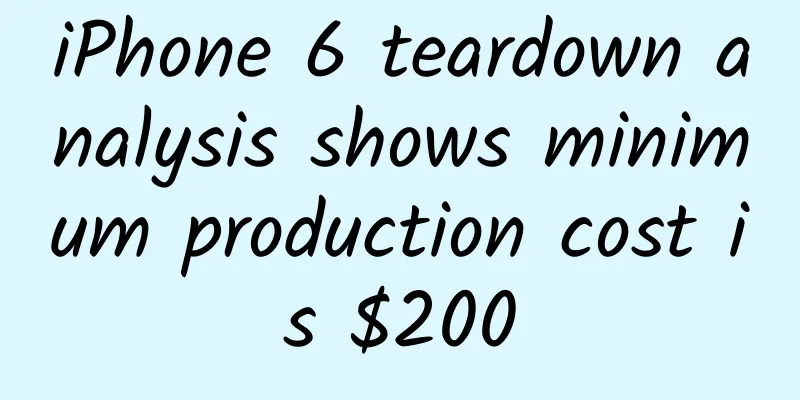iPhone 6 teardown analysis shows minimum production cost is $200

|
According to a disassembly analysis by market research firm IHS, the parts and labor costs of Apple 's new iPhone 6 smartphone range from $200 to $247. The analysis also said that the parts and labor costs for the standard iPhone 6 Plus start at $216, and the 128GB version can reach up to $263. Among them, the assembly line labor cost for each phone is $4 to $4.50. By comparison, the iPhone 6 costs between $649 and $849 without a phone, and the iPhone 6 Plus costs between $749 and $949 without a phone. The iPhone with more memory costs $100 to $200 more than the standard version, but it only costs Apple about $47 more to produce the 128GB version compared to the 16GB version. As a result, the profit margin on the 128GB version is slightly higher than the 16GB version, about 1 percentage point higher: about 70% for the 128GB version and about 69% for the 16GB version. "The pricing model seems to be designed to encourage you to buy the larger memory version," said Andrew Rassweiler, an analyst at IHS. He estimates that Apple pays about 42 cents per gigabyte for memory chips provided by companies such as Micron Technology and Hynix. The profit margins for the iPhone 6 and iPhone 6 Plus are similar to those of Apple's recent iPhone models, but higher than earlier iPhones. Teardowns of the iPhone 5, released in 2012, and the iPhone 5s, released last year, showed profit margins of about 69 percent, while the lower-priced iPhone 5c, also released in 2012, had margins closer to 68 percent. By comparison, the first iPhone, released in 2007, had profit margins of about 55 percent. The most expensive parts of the iPhone 6 and iPhone 6 Plus are the integrated display and touch screen. The displays of these two phones are provided by LG and Japan Display, the world's largest smartphone display manufacturer. The cost price of the iPhone 6 display is $45, and the iPhone 6 Plus is $52.50. Compared with the 4-inch display used in the iPhone 5s, the cost price of the iPhone 6's 4.7-inch display is only $4 higher. Corning continues to supply Apple with so-called "Gorilla Glass" to protect the outer layer of the display. Lasswell said both new iPhones use "Gorilla Glass 3," the third generation of Corning 's product. There had been market rumors that Apple might switch to sapphire displays, with GT Advanced Technologies providing the material. But Lasswell said sapphire was actually used to protect the main buttons and cameras of the two new phones. The new iPhone uses the A8 processor designed and produced by Apple. Lasswell said that the processor he saw during the disassembly was produced by TSMC , and pointed out that TSMC is one of the few manufacturers capable of producing such 20-nanometer chips. Despite the legal dispute between Apple and Samsung, Apple has previously used chips provided by Samsung. However, the deterioration of relations between the two parties has prompted Apple to transfer some of its chip foundry production work to TSMC. According to Lasswell, about 60% of Apple's chips are currently produced by TSMC, while Samsung only accounts for 40%. IHS estimates that the A8 processor plus an auxiliary processor responsible for processing sensor information costs $20, which is $3 more than the iPhone 5s based on the A7 processor. He said that the A8 processor "has more processing power than the A7, but is about 13% smaller in size." Generally speaking, smaller chip size means lower energy consumption when providing the same computing power. Lasswell pointed out: "The 20-nanometer processor is a new cutting-edge product, and it is a major move for Apple to switch to this processor and change suppliers." One of the new features of the iPhone 6 and iPhone 6 Plus is near-field communication (NFC), which enables the Apple Pay mobile payment service. NXP Semiconductors is responsible for producing the main NFC chip for the new iPhones, while ams AG is responsible for providing the so-called "NFC booster" chip, which can improve the signal range and performance. "NXP Semiconductors is the supplier of all NFC chips used in these two phones, but the chip from ams has never been used before," said Laswell. IHS categorizes the two NFC chips as "user interface and sensors" components, a category that costs $22. In addition to NFC chips, the category includes audio chips provided by Cirrus Logic, accelerometer chips provided by InvenSense and another accelerometer chip provided by Bosch Sensortec. "We're not sure why the second accelerometer is needed, but it may be for increased accuracy," Laswell said. In addition, Bosch Sensortec also provides Apple with a pressure sensor for detecting altitude, a feature that has not appeared in previous iPhone models. Apple's other suppliers include chip companies Broadcom and Qualcomm , which provide it with WiFi, Bluetooth and cellular network access chips as well as power management chips. As a winner of Toutiao's Qingyun Plan and Baijiahao's Bai+ Plan, the 2019 Baidu Digital Author of the Year, the Baijiahao's Most Popular Author in the Technology Field, the 2019 Sogou Technology and Culture Author, and the 2021 Baijiahao Quarterly Influential Creator, he has won many awards, including the 2013 Sohu Best Industry Media Person, the 2015 China New Media Entrepreneurship Competition Beijing Third Place, the 2015 Guangmang Experience Award, the 2015 China New Media Entrepreneurship Competition Finals Third Place, and the 2018 Baidu Dynamic Annual Powerful Celebrity. |
<<: "Rod" for smart devices and shout innovative sound "Rod" speaker experience
Recommend
In the mobile era, the opportunity for community 3.0 has arrived
The ancients said that things never happen in thr...
"Tiktok Operation Basics Systematic Course" The perfect transformation from a Tiktok rookie to a big shot
Tiktok practical advanced course, experience the ...
Why do you feel marketing has become difficult?
Re-think: “ Marketing Jobs” This time, I hope to ...
Postpartum weight loss: Easily train your waist and back
Postpartum weight loss: Easily train your waist a...
Why do the leaves of the sycamore look like little palms?
Author: Hao Yun Reviewer: Wang Kang, Director of ...
Earth Hour: If you want to make the earth "easier", you can do these things →
The "Earth Hour" event is a global even...
Learn to avoid these words, and you will be a master at choosing yogurt
The "yogurt" you often buy may be fake ...
Based on the phenomenon of product homogeneity, can operations personnel become the main force in product development?
Generally speaking, the product-related positions...
The 3rd Taobao Violence Project Course Video of Drainage Brother
1. Project Introduction When you buy things on Ta...
People who have the habit of eating fish live longer!
Compiled by: Gong Zixin The Japanese are used to ...
Are parasites reliable as drug "couriers"? | Ficus microcarpa
Hello, I am Rong Ge from the China Science and Te...
iOS-CoreLocation: I know where you are!
1. Positioning Steps: Create a CLLocationManager ...
Tips for placing ads on TikTok’s information feed!
How to attract consumers’ attention within three ...
Is the pangolin the real-life version of "Wolverine"?
Source: China National Geographic Exploration Pla...
Guangzhou Qinpu Mini Program development functions, which company is the best for Qinpu Mini Program development?
Many people cannot express their love for music i...









